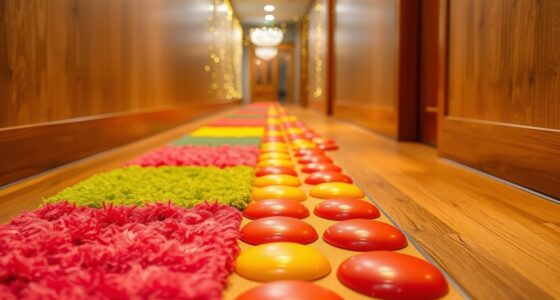To safely provide vestibular input at home through spinning and swinging, always supervise your child and use sturdy, secure equipment. Incorporate activities like swinging, spinning, and balancing on foam pads or beams, gradually increasing intensity while watching for signs of dizziness or overwhelm. Place soft mats underneath to prevent injuries and set clear boundaries for safe play. If you want to discover how to create a fun, safe vestibular space, keep exploring these helpful tips.
Key Takeaways
- Incorporate swinging and spinning activities like swings and sit-and-spin toys to stimulate vestibular input safely at home.
- Always supervise children during vestibular activities and use sturdy, secure equipment to prevent accidents.
- Create a dedicated space with soft mats and ample room for safe movement and activity variety.
- Limit spinning sessions to avoid dizziness and combine calming activities with stimulating ones based on individual needs.
- Establish clear safety rules and gradually increase activity intensity to prevent overwhelm and ensure a fun, safe experience.

If you’re looking to support your child’s sensory development at home, incorporating vestibular input can be highly effective. One of the best ways to do this is through engaging in simple balance exercises and sensory activities that stimulate the vestibular system. These activities help improve your child’s sense of spatial awareness, coordination, and overall balance, making everyday tasks easier and more enjoyable. You might start with activities like standing on one foot, walking along a straight line, or balancing on a foam pad. These exercises challenge their balance in a gentle, controlled way, encouraging their body to adapt and strengthen.
Engage your child with simple balance exercises to boost coordination and sensory development at home.
In addition to balance exercises, incorporating sensory activities such as swinging or spinning can provide excellent vestibular stimulation. Swings, in particular, are fantastic tools because they allow your child to experience rhythmic, repetitive movement that activates the vestibular system. Make sure to use a sturdy, well-secured swing, and always supervise closely to ensure safety. Gentle swinging back and forth can be calming, while more vigorous spinning can be stimulating, depending on your child’s needs. Just remember not to overdo it—limit spinning sessions to a few minutes to avoid dizziness or discomfort.
Safety is paramount when doing vestibular activities at home. Always supervise your child closely, especially during swinging or spinning, to prevent falls or injuries. Use soft mats or carpets underneath swings and spinning stations to cushion any accidental falls. Check that equipment is secure and in good condition before use. If your child gets overwhelmed or shows signs of dizziness, stop the activity immediately and let them rest. It’s also wise to establish clear boundaries and rules for these activities, so your child understands what’s safe and what’s not.
Creating a dedicated space for vestibular activities can make the experience more inviting and organized. For example, set up a cozy corner with a sturdy swing or a balance beam, and keep plenty of space around for movement. Incorporate different sensory activities that involve spinning, swinging, or rocking to keep your child engaged and stimulated. Remember to start slow and gradually increase activity intensity as your child’s tolerance improves. The goal is to make these activities fun and beneficial, helping your child’s sensory system develop without overwhelming them.
Frequently Asked Questions
Are There Age Restrictions for Vestibular Activities at Home?
Yes, age restrictions matter for vestibular activities at home. You should choose age-appropriate activities that match your child’s developmental stage and always supervise closely. Younger children need gentle, simple movements, while older kids can handle more dynamic activities. Keep safety in mind by ensuring equipment is secure and supervising at all times, especially during spinning or swinging. This way, you support their sensory needs without risking injury.
How Can I Tell if My Child Is Over-Stimulated?
You notice your child’s eyes dart, their fidgeting escalates, and they suddenly cover their ears—these behavioral cues signal sensory overload. If they seem overwhelmed, they might be over-stimulated from vestibular activities. To prevent further distress, watch for signs like irritability or withdrawal. When you see these cues, gently stop the activity and offer calming, predictable routines. Trust your instincts—your awareness helps keep your child safe and comfortable.
What Signs Indicate a Need to Stop Vestibular Activities Immediately?
If you notice signs to watch for like dizziness, nausea, or crying during vestibular activities, you should immediately cease the activity. Watch for signs of disorientation, excessive fatigue, or a child trying to stop themselves. When these signs appear, it’s crucial to stop immediately to prevent overstimulation or discomfort. Your quick response helps keep your child safe and ensures they don’t experience unnecessary distress.
Can Vestibular Input Help With Sensory Processing Disorder?
Think of vestibular input as a dance with your senses, helping to fine-tune sensory integration. It can indeed support those with sensory processing disorder by providing movement therapy that calms or energizes. This active engagement helps your brain better interpret sensory signals, improving coordination and focus. With guided, safe activities, vestibular input becomes a powerful tool for managing sensory challenges, allowing you to better navigate your environment with confidence.
How Do I Create a Safe Environment During Swinging or Spinning Activities?
You should prioritize safety precautions by ensuring stable equipment selection, like secure swings or spin seats, and placing them on soft, level surfaces. Always supervise closely, check for loose parts or damage before use, and avoid over-spinning to prevent dizziness or falls. Use harnesses or safety bars when possible, and establish clear boundaries to keep your child safe during swinging or spinning activities.
Conclusion
Now that you know how to bring vestibular activities home, imagine the adventures waiting just around the corner. Will your next spin or swing unlock new confidence or calmness? The possibilities are endless, but safety always comes first. Are you ready to explore these exciting, sensory-rich experiences? Keep your eyes open—you never know when the next thrilling movement might transform your day in ways you never expected. The journey has only just begun.










